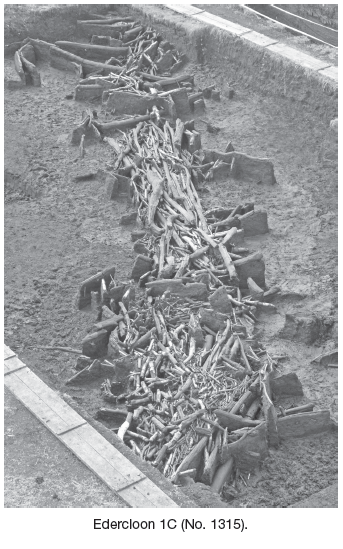County: Longford Site name: EDERCLOON
Sites and Monuments Record No.: N/A Licence number: A031/025, E3313
Author: Caitríona Moore, CRDS Ltd.
Site type: Excavation - miscellaneous
Period/Dating: Prehistoric (12700 BC-AD 400)
ITM: E 606811m, N 785043m
Latitude, Longitude (decimal degrees): 53.814870, -7.896571
A programme of archaeological excavations was undertaken as part of the N4 Dromod Roosky bypass at the request of Leitrim County Council. In total, 25 potential archaeological sites were identified during centreline testing as part of the advance archaeological investigation (see No. 1214, Excavations 2006, 05E0983).
Archaeological deposits were identified within the development footprint in an area of reclaimed bog. Excavation of the site was carried out from 3 April to 31 August 2006. At its peak, over 120 archaeologists were involved in the excavations.
The excavation covered an area c. 170m (north–south) by 30m, which was divided into 28 trenches. The archaeological deposits comprised a dense complex of 48 individual sites. These were eight primary toghers, seven secondary toghers, twelve tertiary toghers, five platforms and seventeen deposits of archaeological wood. They were almost entirely constructed of brushwood, roundwoods, twigs and pegs, with split timbers and stone occasionally included. Notable amongst the primary toghers was the volume and depth of material used in their construction, with several sites measuring over 1.2m deep. Also prominent was the north–south orientation of fourteen toghers, indicating a marked preference for movement in this direction.
The platforms ranged from large well-defined square or rectangular areas of parallel roundwoods and brushwood to haphazard but dense deposits of wood. Several platforms were directly associated with toghers and it is possible in several locations that the convergence of two or more toghers created platform areas. The seventeen deposits of archaeological wood were generally small and irregular and likely to relate to the larger sites in their vicinity.
A total of 51 wooden artefacts were recovered during the excavation, predominantly deposited in the base of the structures. Nine wooden vessels (both complete and fragmentary) of varying styles were found, as were three fragmentary withes and six pieces of brushwood trained to grow in a spiralling pattern. Two wheel-rim fragments and a portion of a block wheel were recovered from two toghers. Two spear shafts or possible harpoons were found deposited close together in a primary togher. An extensively worked and dressed object with symmetrical pointed ends was recovered from a small platform and a split timber with six equidistant rectangular notches and dowels was discovered in the base of an adjacent togher. Other wooden artefacts included wooden mallets, possible walking sticks, club-like objects and possible tool handles.
Leather finds consisted of three post-medieval leather shoes retrieved from topsoil and the fragmentary remains of a shoe or pouch recovered from a deposit of archaeological wood.
Radiocarbon dates indicate that the complex dates from the Neolithic to the medieval period, with a peak of activity in the Bronze and Iron Ages.
At Edercloon the density of large structures in such a small area is notable, particularly given that many of the sites appear to be contemporary. The scale, in particular the depth, of the toghers is also exceptional and is atypical of other excavated trackways in Ireland. In addition, the quantity and quality of artefacts is remarkably high. Research and analysis of the findings are under way, as is a comprehensive post-excavation programme involving several disciplines.
To the north-west of Edercloon, in the townland of Tomisky, three tertiary toghers and four deposits of archaeological wood were excavated (see No. 1322, Excavations 2006, A031–024). Located c. 100m north-west of the northern extent of Edercloon, these sites are likely to be part of the same archaeological complex.


Unit 4A, Dundrum Business Park, Dublin 14